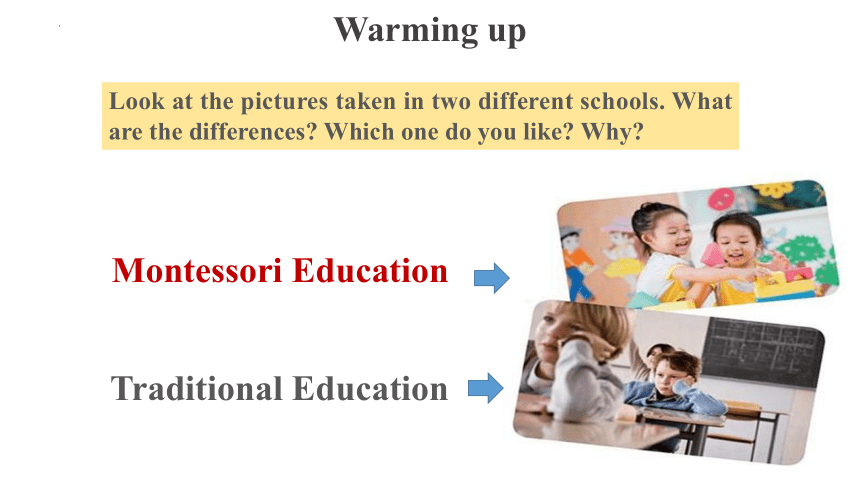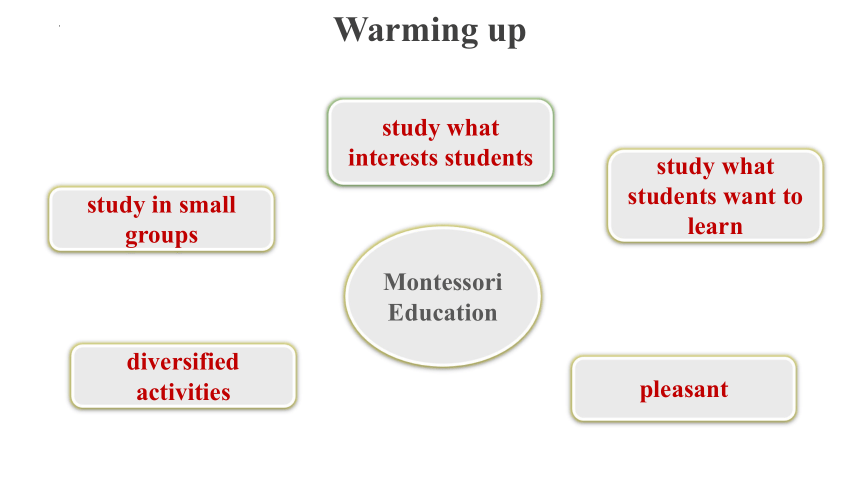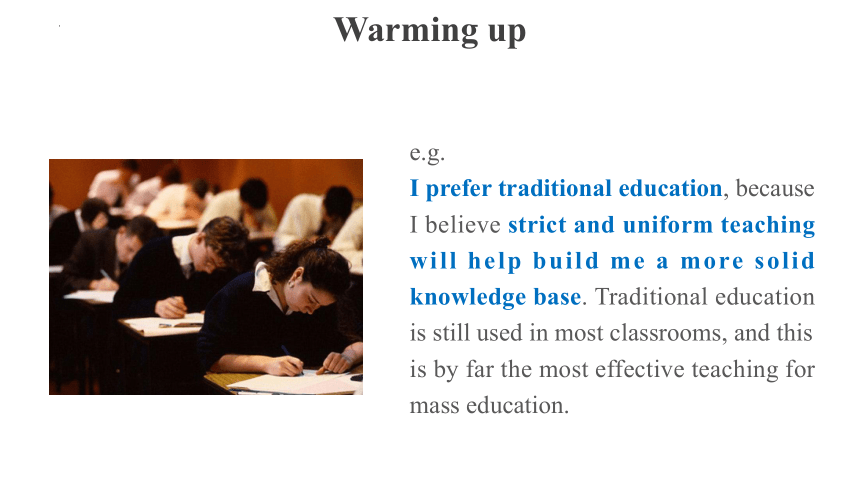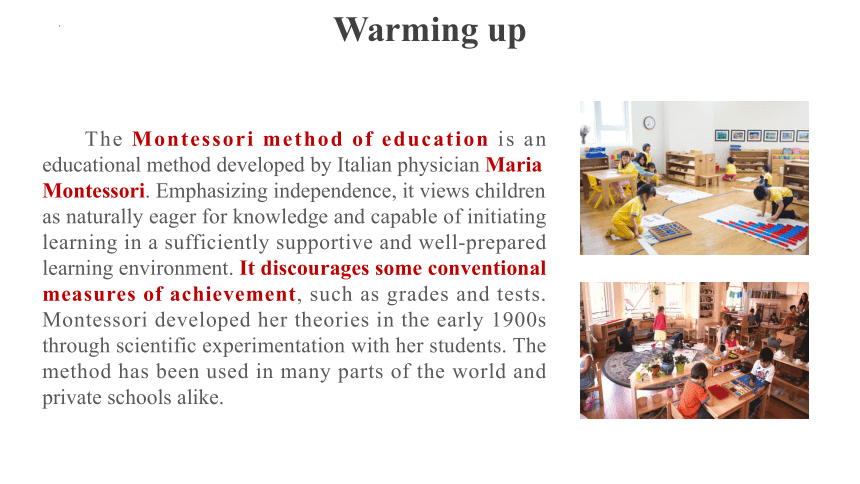北师大版(2019) 选择性必修第二册 Unit 5 Education Viewing Workshop 课件(15张PPT)
文档属性
| 名称 | 北师大版(2019) 选择性必修第二册 Unit 5 Education Viewing Workshop 课件(15张PPT) |  | |
| 格式 | pptx | ||
| 文件大小 | 6.3MB | ||
| 资源类型 | 教案 | ||
| 版本资源 | 北师大版(2019) | ||
| 科目 | 英语 | ||
| 更新时间 | 2022-12-28 17:31:37 | ||
图片预览







文档简介
(共15张PPT)
Unit 5 Education
Viewing Workshop
Warming up
Montessori Education
Traditional Education
Look at the pictures taken in two different schools. What are the differences Which one do you like Why
Montessori Education
study in small groups
study what students want to learn
study what interests students
diversified activities
pleasant
Warming up
e.g.
I like Montessori education because as a student, I will have the freedom to decide what I will learn, and I believe I will fully realize my potential.
Warming up
Traditional Education
study as a whole
study what the teacher wants students to learn
uniform teaching and evaluation
boring
strict
Warming up
e.g.
I prefer traditional education, because I believe strict and uniform teaching will help build me a more solid knowledge base. Traditional education is still used in most classrooms, and this is by far the most effective teaching for mass education.
Warming up
The Montessori method of education is an educational method developed by Italian physician Maria Montessori. Emphasizing independence, it views children as naturally eager for knowledge and capable of initiating learning in a sufficiently supportive and well-prepared learning environment. It discourages some conventional measures of achievement, such as grades and tests. Montessori developed her theories in the early 1900s through scientific experimentation with her students. The method has been used in many parts of the world and private schools alike.
Warming up
Maria Tecla Artemisia Montessori (/ m nt s ri/ August 31, 1870—May 6, 1952) was an Italian physician and educator best known for the philosophy of education that bears her name, and her writing on scientific pedagogy(教育学). At an early age, Montessori broke gender barriers and expectations when she enrolled in classes at an all-boys technical school, with hopes of becoming an engineer. She soon had a change of heart and began medical school at the Sapienza University of Rome, where she graduated with honors in 1896. Her educational method is in use today in many public and private schools globally.
Warming up
Viewing
Watch Part 1 of the plete the information.
Rob Gueterbock is a Montessori ________. He’s been working with children for ________. He did so for two reasons. First, he ________________ the journey that each one has made, from a small cell to a ______________________ adult human being; and secondly, its just _______________ to spend a day to see the children working so independently and ___________ as a community of human beings working together.
guide
7 years
was fascinated by
complex, walking, talking
a beautiful way
functioning
( ) 1 Children don’t want to learn by themselves.
( ) 2 Children want to explore the world around them.
( ) 3 Children don’t want to learn things that are told to them.
( ) 4 Children learn best when they’re following their own interests.
( ) 5 Children don’t learn by doing, but by listening or talking.
F
T
T
T
F
Viewing
Watch Part 2 of the video. Write T (true) or F (false).
Montessori education and traditional education Montessori Features a Children experience learning at their own pace. b Lessons are done in a whole class. c Children are banded by age. d Children learn in mixed-age communities. e Value cooperation. f Encourage competition.
g Lessons tend to be individual or in small groups.
h They use the word “teacher” instead of “guide”.
i Teaching begins with a curriculum.
Traditional Viewing
Watch Part 3. What are the differences between Montessori education and traditional education Put the features (a-i) into the right columns.
a d e g i
b c f h i
Viewing
Watch Part 4 of the video. What stages of education can the Montessori Method be applied on What does Rob mean by “If we give children active toys, then we end up with passive children”
In the UK, most Montessori schools are pre-schools. But in America and other parts of the world, there are Montessori secondary schools that go all the way through to 18.
Active toys stop children to create by themselves and children would be passive. Passive toys give children space to be active, and that leads to active children.
Discussion
Hands-on learning which leads to better understanding
Positive social interaction and acquiring of social skills
Independent learning which breeds responsibility and a love for learning
Inclusive of different students’ needs
Advantages include:
What are the advantages of Montessori education What are the possible drawbacks Discuss with your partner.
It is not accessible for everyone.
The curriculum is not structured enough for some students.
The open-ended structure of the classroom can be intimidating for some students.
Disadvantages include:
Assignment
Try to search more information about educational methods and share it with your classmates.
Goodbye!
Unit 5 Education
Viewing Workshop
Warming up
Montessori Education
Traditional Education
Look at the pictures taken in two different schools. What are the differences Which one do you like Why
Montessori Education
study in small groups
study what students want to learn
study what interests students
diversified activities
pleasant
Warming up
e.g.
I like Montessori education because as a student, I will have the freedom to decide what I will learn, and I believe I will fully realize my potential.
Warming up
Traditional Education
study as a whole
study what the teacher wants students to learn
uniform teaching and evaluation
boring
strict
Warming up
e.g.
I prefer traditional education, because I believe strict and uniform teaching will help build me a more solid knowledge base. Traditional education is still used in most classrooms, and this is by far the most effective teaching for mass education.
Warming up
The Montessori method of education is an educational method developed by Italian physician Maria Montessori. Emphasizing independence, it views children as naturally eager for knowledge and capable of initiating learning in a sufficiently supportive and well-prepared learning environment. It discourages some conventional measures of achievement, such as grades and tests. Montessori developed her theories in the early 1900s through scientific experimentation with her students. The method has been used in many parts of the world and private schools alike.
Warming up
Maria Tecla Artemisia Montessori (/ m nt s ri/ August 31, 1870—May 6, 1952) was an Italian physician and educator best known for the philosophy of education that bears her name, and her writing on scientific pedagogy(教育学). At an early age, Montessori broke gender barriers and expectations when she enrolled in classes at an all-boys technical school, with hopes of becoming an engineer. She soon had a change of heart and began medical school at the Sapienza University of Rome, where she graduated with honors in 1896. Her educational method is in use today in many public and private schools globally.
Warming up
Viewing
Watch Part 1 of the plete the information.
Rob Gueterbock is a Montessori ________. He’s been working with children for ________. He did so for two reasons. First, he ________________ the journey that each one has made, from a small cell to a ______________________ adult human being; and secondly, its just _______________ to spend a day to see the children working so independently and ___________ as a community of human beings working together.
guide
7 years
was fascinated by
complex, walking, talking
a beautiful way
functioning
( ) 1 Children don’t want to learn by themselves.
( ) 2 Children want to explore the world around them.
( ) 3 Children don’t want to learn things that are told to them.
( ) 4 Children learn best when they’re following their own interests.
( ) 5 Children don’t learn by doing, but by listening or talking.
F
T
T
T
F
Viewing
Watch Part 2 of the video. Write T (true) or F (false).
Montessori education and traditional education Montessori Features a Children experience learning at their own pace. b Lessons are done in a whole class. c Children are banded by age. d Children learn in mixed-age communities. e Value cooperation. f Encourage competition.
g Lessons tend to be individual or in small groups.
h They use the word “teacher” instead of “guide”.
i Teaching begins with a curriculum.
Traditional Viewing
Watch Part 3. What are the differences between Montessori education and traditional education Put the features (a-i) into the right columns.
a d e g i
b c f h i
Viewing
Watch Part 4 of the video. What stages of education can the Montessori Method be applied on What does Rob mean by “If we give children active toys, then we end up with passive children”
In the UK, most Montessori schools are pre-schools. But in America and other parts of the world, there are Montessori secondary schools that go all the way through to 18.
Active toys stop children to create by themselves and children would be passive. Passive toys give children space to be active, and that leads to active children.
Discussion
Hands-on learning which leads to better understanding
Positive social interaction and acquiring of social skills
Independent learning which breeds responsibility and a love for learning
Inclusive of different students’ needs
Advantages include:
What are the advantages of Montessori education What are the possible drawbacks Discuss with your partner.
It is not accessible for everyone.
The curriculum is not structured enough for some students.
The open-ended structure of the classroom can be intimidating for some students.
Disadvantages include:
Assignment
Try to search more information about educational methods and share it with your classmates.
Goodbye!
同课章节目录
- Unit 4 Humour
- Lesson 1 What’s So Funny?
- Lesson 2 Why Do We Need Humour?
- Lesson 3 My Favourite Comedian
- Unit 5 Education
- Lesson 1 Enlightening a Mind
- Lesson 2 The Objectives of Education
- Lesson 3 Understanding
- Unit 6 The Media
- Lesson 1 From Page to Screen
- Lesson 2 Questions about Media
- Lesson 3 The Advertising Game
